Your Ultimate Guide To The Types of Geothermal Energy
Check Out All The Different Uses For Geothermal Power
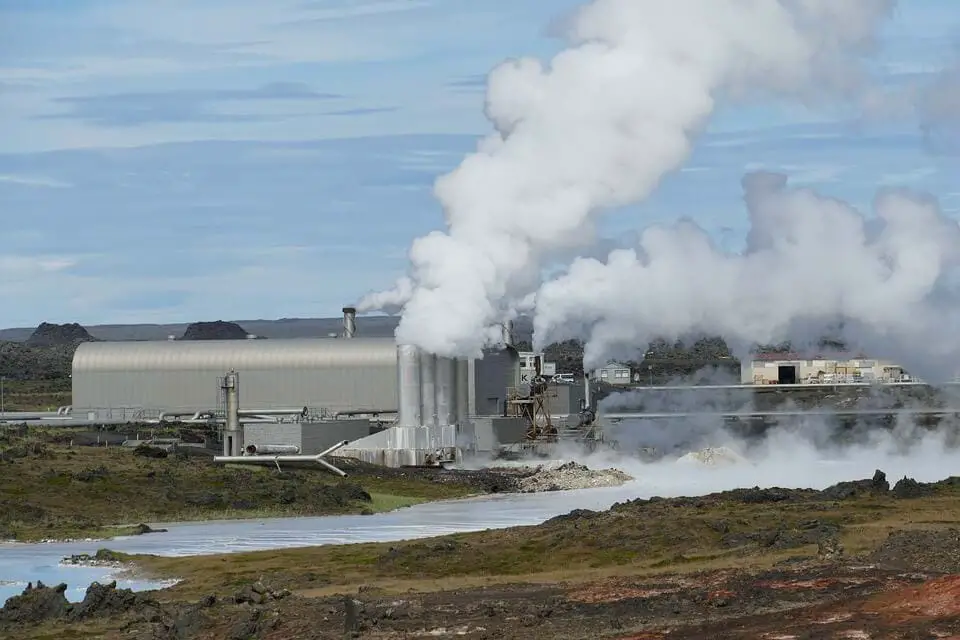
While geothermal energy is available everywhere, only about 10 percent of the world has the geothermal resources required to generate electricity.
Geothermal energy uses heat that originates within the earth that occurs from a combination of two different sources. The first is the original heat that got produced from the formation of the land by gravitational collapse. The second source is from the heat generated by radioactive decay from various isotopes[3].
Geothermal energy is a clean energy source, but unfortunately, it is not technically as renewable as other sources like solar and wind power.
When we are capturing the sun or wind available, it does not have any effect on their future availability.
On the other hand, when we are using local sources of thermal energy, the reinjection of the thermal fluids into the reservoir can gradually reduce the amount of heat accessible.
New technologies are getting developed to allow for drilling too much greater depths(around 15, 000 feet deep). If we can drill to this depth, we go from being able to generate electricity from 10 percent of the eath to creating geothermal power in almost any area of the world.[1]
Geothermal resources for electricity generation can get divided into four different types:
Different Sources of Geothermal Energy
Hydrothermal
Not currently used for the generation of electricity. Hydrothermal resources do not contain the high levels of temperature needed for efficient electricity generation. Hydrothermal resources now get used in the heat and cooling of businesses and homes.
Geopressured
Geopressured resources are the most common source for our Flash Steam geothermal plants.
These resources get found when there is a layer of rock that is trapping a geothermal reservoir, increasing the pressure it is under and its temperature.
Hot Dry Rock
These are areas that do not contain any water reservoirs but contain the heat levels in ground rocks needed for geothermal fluids. Water gets injected to produce the steam required. Check out the Enhanced Geothermal Systems section near the end of the article for more details.
Magma
We don't actually drill into the magma chamber but into the rocks surrounding it. The temperatures here can reach all the way up to 800F.
The extreme temperature from molten rock and the pressurized water create what scientists call "supercritical water." This water is not considered a liquid or solid and has much higher energy output than any other geothermal steam types. Scientists estimate this source can generate up to 10 times the amount of energy when than other geothermal sources[13].
We are currently using geothermal energy in 2 primary ways.
- 1. Heating and Cooling of Businesses and Residential Homes
- 2. Generate Electricity
Geothermal Energy For Residential/Business Heating
Heat pumps use the heat contained in shallow soil, all existing applications of geothermal energy make use of hydrothermal resources. If the temperature of the supply is higher than 90C, it can get used to generate electricity[3].
At a depth of 10 meters to a few hundred meters deep, there is a steady supply of milder heat that can get used for direct heating and cooling. The advantage of geothermal energy for direct heating and cooling is the fact that almost every location on earth can utilize it[2].
By switching our heating systems over to geothermal energy, we can also reduce the number of fossil fuels getting burned.
Geothermal Energy for Power Production
Types of Geothermal Power Plants
From what I could find, there are three different types of geothermal power plants currently in use. They are Dry Steam, Flash Steam, and binary systems.
All three types of geothermal power plants generate electricity using the same basic method.
They all use turbines that get connected to generators that the turbines will rotate, this rotation causes magnets to move around a coil of wire to induce a current.
The amount of energy generated depends on two primary factors — the number of loops in the coil of wire and the speed the moving magnets.
Dry Steam and Flash Steam Geothermal power plants require high-temperature between 300°F to 700°F.
Geothermal power plants are generating electricity in almost precisely the same way as fossil fuels. In both cases, we use steam to drive a turbine activating the generator to generate electricity.
But all three geothermal systems have a much smaller land footprint when compared to there fossil fuel counterpart. And geothermal energy is capable of operating around the clock like fossil fuels.
One of the fundamental costs associated with geothermal wells is drilling them. Research is focusing on more efficient ways of drilling into hard rocks at high temperatures and corrosive environments to help reduce the cost of the process[3].
Luckily a new technique called slimhole drilling has helped reduce these costs by up to 50%.
Dry Steam
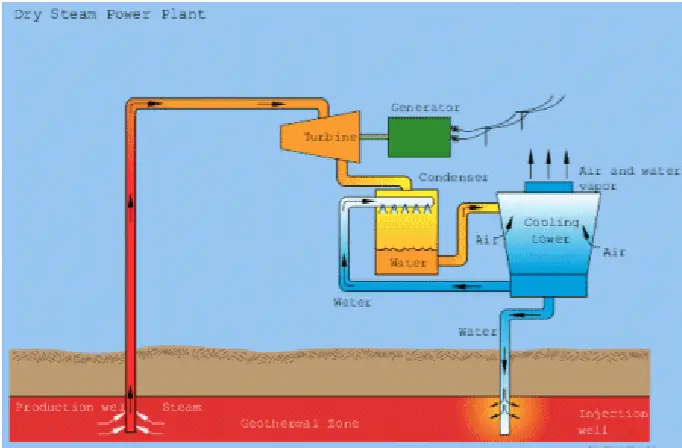
Dry steam is the oldest type of geothermal power for electricity generation we have been using. There first use I could find was in Italy at Lardarello in 1904.
It is also the most basic design that we are using to generate electricity from geothermal resources.
This exact system is still used today in Northern California, one of the worlds largest geothermal power plants[6].
Dry Steam power plants directly use the steam from hydrothermal fluids. We get to these fluids by drilling production wells down into an underground layer of water-bearing permeable rock. These contain superheated, pressurized steam (180°-350°C)[7].
The steam is brought to the surface and gets channeled to a turbine. The pressure from the steam causes the turbine to spin. The turbine gets connected to a generate from producing electricity.
In the most basic design, the low-pressure steam gets directly vented out into our atmosphere[7].
In most modern systems, the steam that was used to spin the turbine gets collected in what is called a condenser. The condenser turns the steam back into liquid form. The liquid is passed down the injection well so it can get added back into the reservoir.
While these are the most cost-effective technology sites capable of the natural steam production required are limited compared to the flash steam systems[3].
Availability of this resource is so limited that there are only 2 identified locations in the United States that are capable of using this system(Yellowstone National Park, Northern California)[8].
Flash Steam
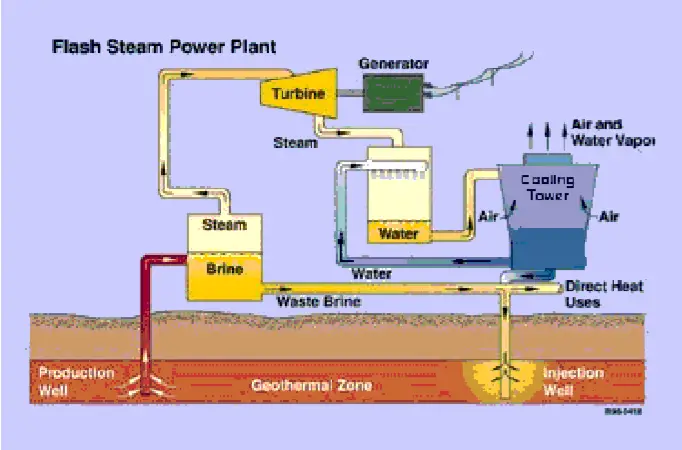
Flash steam also called liquid dominated plants, is currently the most used system to generate electricity from geothermal resources.
Flash steam systems get built on a liquid dominated reservoirs within the earth surface. The high pressure of the water passes through one or more separators to lower its pressure creating steam[9]. The created steam is now used to propel the turbines generating electricity.
The steam then gets passed through a condenser, converting it to a liquid. The water now gets reinjected back into the reservoir through an injection well pump.
It gets its name because it uses the hot water and sprays it into a tank where its pressure gets quickly reduced. The reduced pressure quickly flashes the water to produce steam[3].
Flash steam systems are only useful for temperatures that are above 300F (~145C). Dropping below this temperature significantly reduces the efficiency of the plant[3].
When temperatures drop below this level binary systems are required to generate power efficiently[3].
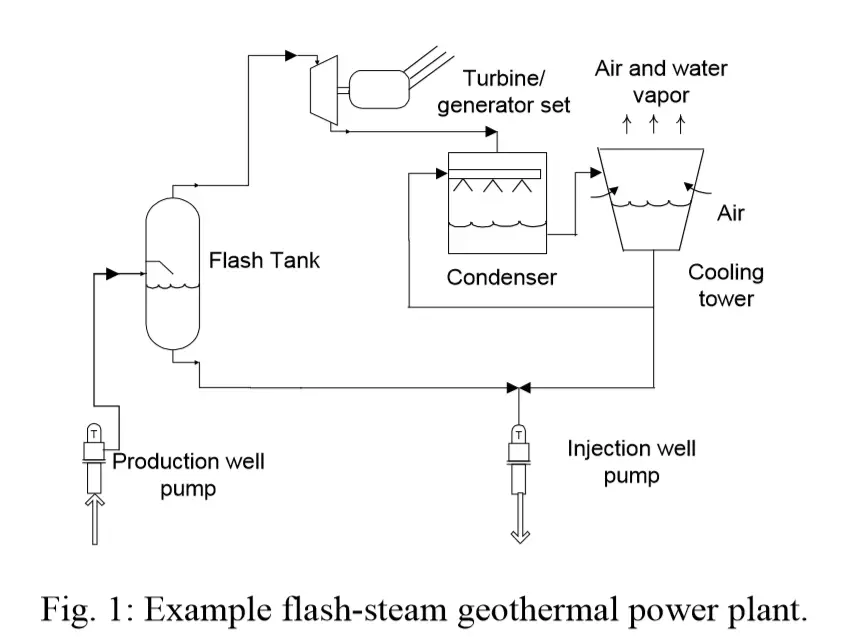
Binary Cycle
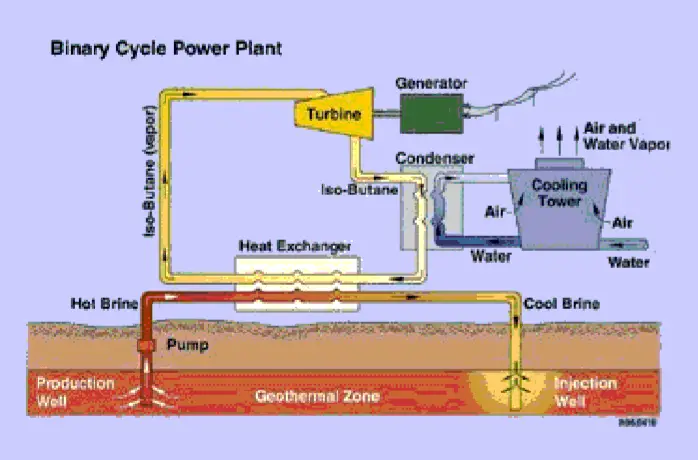
Binary geothermal systems operate between 100F(~35C) to 300F(~150C)[11]. These systems use a newer design for generating electricity from geothermal resources than the other two methods already covered.
The primary difference between binary plants and dry steam and flash steam systems is that a secondary fluid gets heated to vapor. This heated fluids vapor is used to spin the turbine instead of the actual geothermal fluids.
The secondary fluid is usually a hydrocarbon like isopentane or a refrigerant[10]. It gets turned into a vapor at a much lower boiling point than water.
The secondary fluid gets selected based off of the temperature range of the geothermal resources available to the specific site[10].
The geothermal energy and working fluid get passed into a heat exchanger. The geothermal fluids heat vaporizes the working liquid converting it to steam. The steam of the working fluid is used to drive the turbines to generate electricity.
The thermal fluids exit the heat exchanger and get directly pumped back down through the injection well to the reservoir. There the liquid gets heated up again by the hot rocks and sucked up the production well continuing the power production cycle.
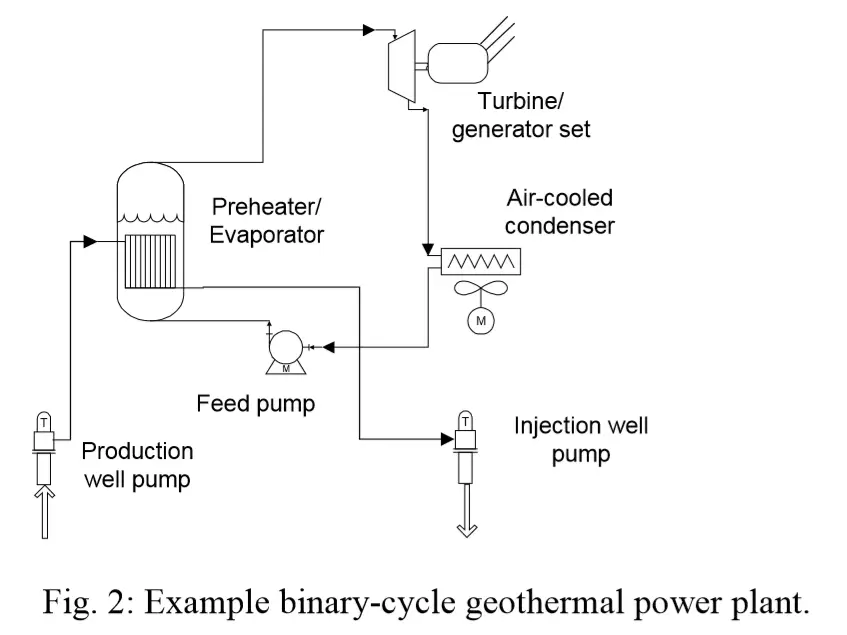
The working fluid gets cooled and collected so that it can get reinjected into the heat exchanger to get flashed into steam again. The Binary system uses a closed-loop, so virtually nothing gets emitted into our atmosphere. Because of the near-zero level of emissions, and the ability to operate at lower temperatures, most new geothermal power plants are going to be using this design[10].
The output power capacity between flash and binary can range between 5 MW up to 100 MW.
This fact seems to make binary plants highly more efficient than their flash system counterpart.
Enhanced Geothermal Systems
Since many areas do not contain geothermal reservoirs but still provide a very hot subsurface, they are perfect for a human-made geothermal lake.
With new and improved drilling techniques, we can create geothermal reservoirs by hydraulic fracturing of dry and impermeable(does not allow water to flow) rock[12].
The amount of liquid passing through the rock can get increased with our new drilling techniques. Then by pumping high-pressure water down the injection well, the heat from the stones and the water passing through there small fractures will create the steam needed.
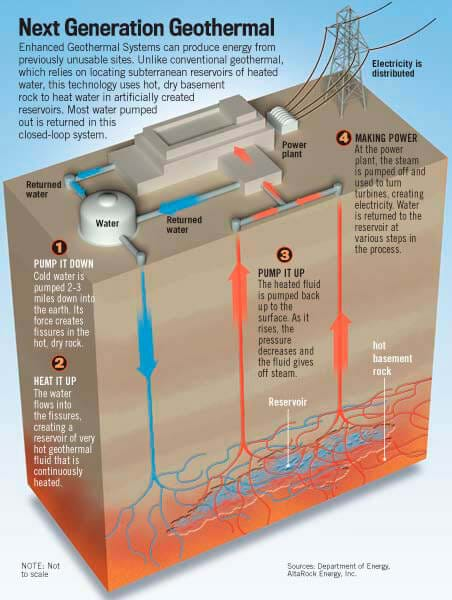
You may also hear of the process called engineered geothermal systems. This system will allow us to expand the use of geothermal energy dramatically[12].
It gets estimated that using this process could increase our power production capabilities from geothermal resources by 40 times their current availability.
What's With All The White Smoke
It is common to see white smoke rising into the air when you are around a geothermal power plant.
At first thought, most people assume that this is greenhouse gas emissions getting released into the air. But the white smoke is not actual emission fumes but just water vapor created from cooling hot steam back to water in the systems cooling tower.
So if you see these white clouds from the power station, there is no need to worry. But to be honest, I would still not walk through them. If the plant was using a dry steam system(which I doubt it would), there could be levels of CO2 and methane in the vapor.
Modular Applications
Geothermal power plants that produce 5 megawatts or less are considered small scale and have widespread use. These distributed energy resources use a variety of miniature modular power-generating technologies that when combined, can help us improve the operation of the electricity delivery system[5].
But plants under 5MW size significantly go up in price because of fixed costs and the loss of the price break when purchasing the equipment at scale[3].
Closing
I was surprised to find out how limited geothermal energy was for generating electricity. While geothermal energy is not as renewable as wind or solar, it is definitely in a way better league than those dirty fossil fuels we keep burning.
We are also using geothermal energy for helping us meet our heating and cooling needs for residential and businesses. By switching more places to using this technique, it can also contribute to reducing the amount of coal we need to burn for power generation.
In the future, I think it could be possible for us to meet most of our energy demands. I believe this demand could get met by incorporating geothermal energy with other our other renewable energy sources like hydro, solar, and wind.
With the new progress getting made with our drilling/fracking technology, I expect geothermal power station energy to increase over the next 10 to 20 years dramatically.
You May Also Like
Geothermal Energy Benefits And Alarming Disadvantages
[1]https://www.alaskapacific.edu/wp-content/uploads/2012/03/Anthony-Bryant-Senior-Project.pdf
[2]https://www.ucsusa.org/clean_energy/our-energy-choices/renewable-energy/how-geothermal-energy-works.html
[3]https://www.nrel.gov/docs/fy00osti/28204.pdf
[4]https://www1.eere.energy.gov/geothermal/pdfs/low_temp_copro_fs.pdf
[5]https://www.renewableenergyworld.com/geothermal-energy/tech/geoelectricity.html#gref
[6]https://www.conserve-energy-future.com/geothermalpowerplanttypes.php
[7]http://www.digtheheat.com/geothermal/dry_steam_plant.html
[8]https://geothermalenergyosu.weebly.com/different-types-of-geothermal-energy.html
[9]https://geothermalenergyosu.weebly.com/different-types-of-geothermal-energy.html
[10]http://large.stanford.edu/courses/2011/ph240/yan2/
[11]http://www.alaskapacific.edu/wp-content/uploads/2012/03/Anthony-Bryant-Senior-Project.pdf
[12]https://www.energy.gov/eere/geothermal/how-enhanced-geothermal-system-works
[13]https://www.livescience.com/57833-scientists-drill-volcano-core-geothermal-energy.html
[14]http://altarockenergy.com/technology/enhanced-geothermal-systems/